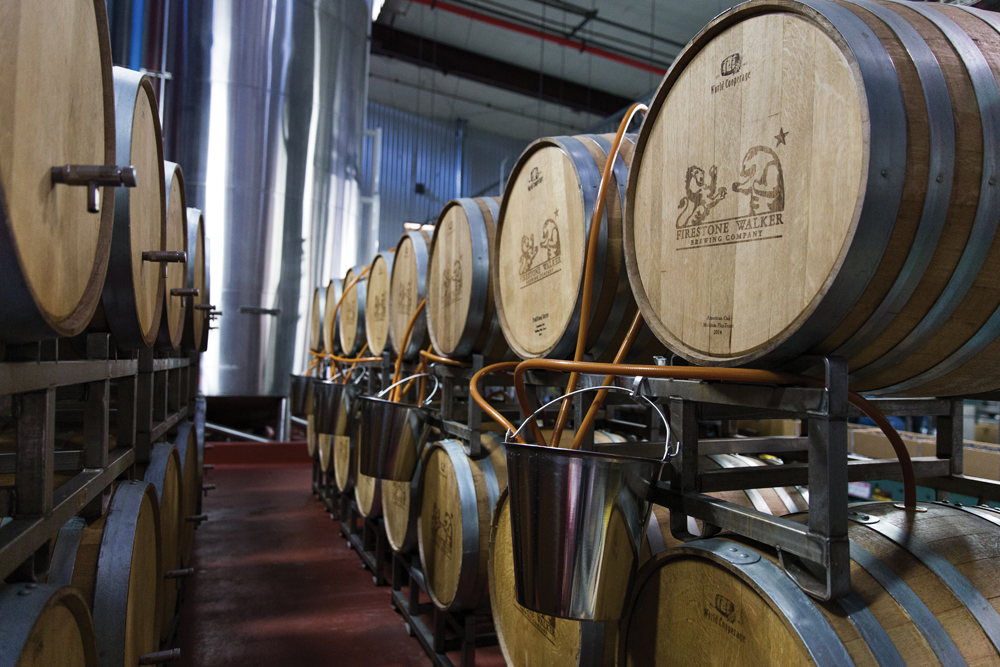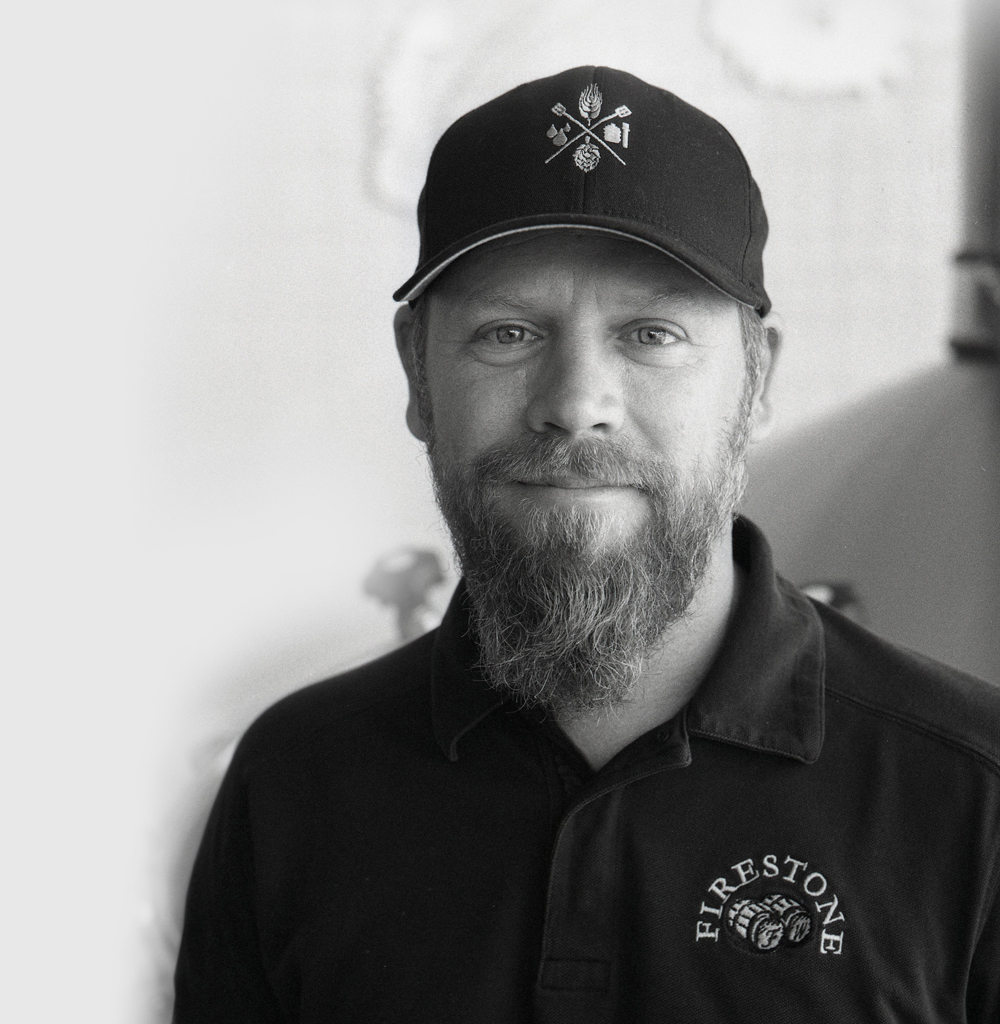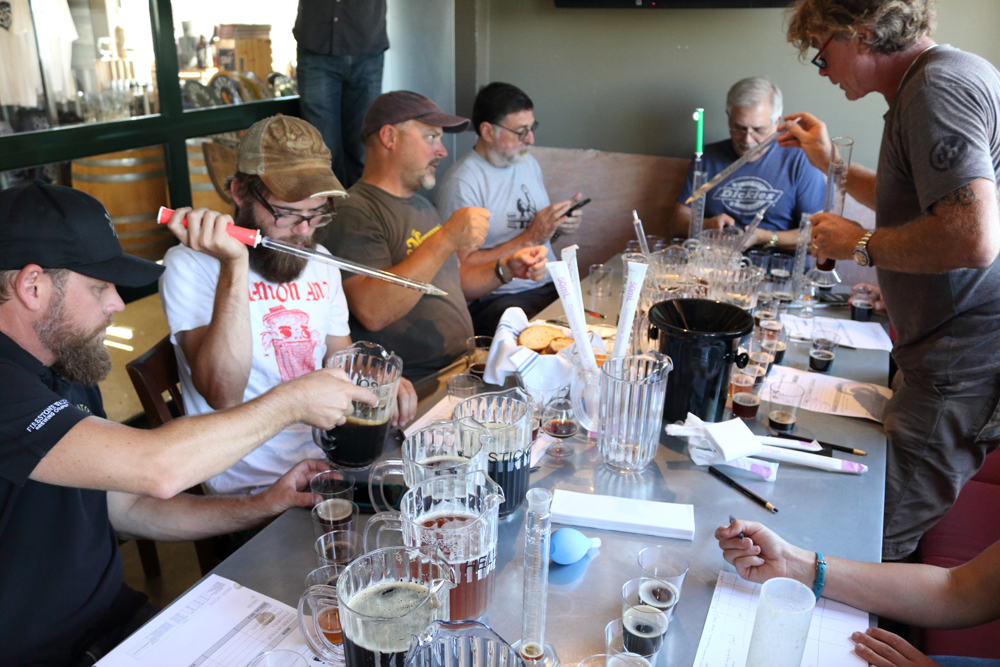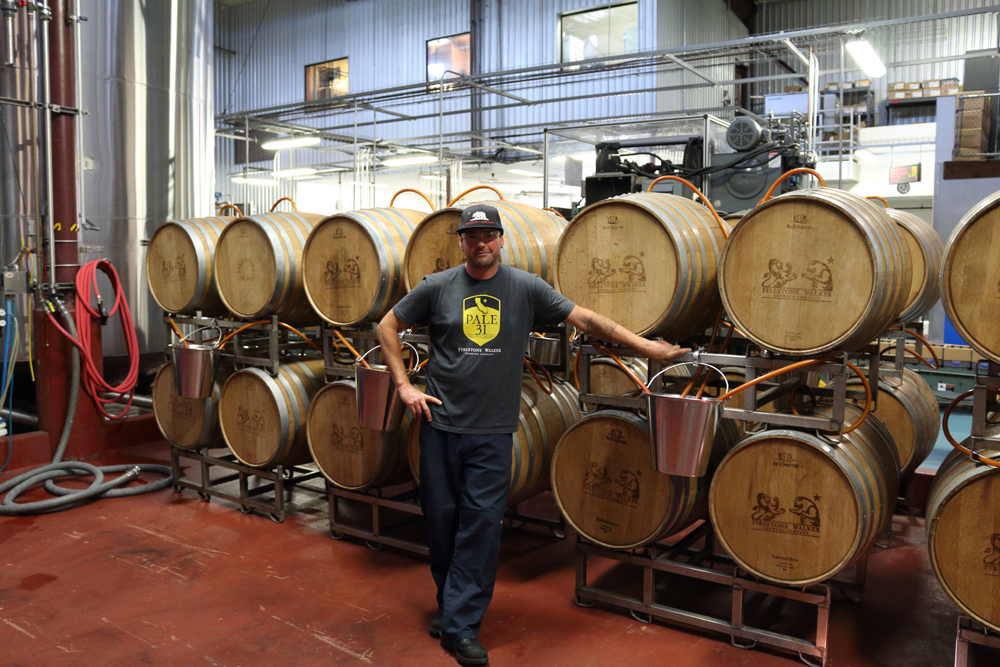Matt Brynildson, brewmaster at Firestone Walker in Paso Robles on California’s central coast, considers himself fortunate to have connected with founders Adam Firestone and David Walker. They no doubt feel fortunate to have him. He’s one of the world’s most respected brewers. Creativity so often gets credit for a brewer’s success, but for Brynildson science laid the foundation and still informs his work.
Like many in this industry, you were originally a homebrewer. How did you go from hobbyist to professional?
I was in a science-based undergraduate program at Kalamazoo College (Michigan) and was hoping to go to medical school. I did an internship at a local spice extraction company called Kalsec Inc, which is a leader in natural spice and flavor extracts, including hop extracts for the brewing industry. I was fortuitously placed in their hops lab and offered a job when I finished school. Then Kalsec offered to pay for some further education in biochemistry and I ended up spending three and a half years working there.
At one point they sent me to the Siebel Institute of Brewing Technology in Chicago for a short course on brewing. It was the mid 1990s, when craft beer was taking off in America. A Goose Island employee stopped by and said they were looking to staff their new production facility in Chicago. All of a sudden I realized I could be a brewer and not just a lab rat. I left Kalsec and went to brew for Goose Island.
How did working at Kalsec prepare you for Goose Island? Were you involved in any relevant research?
The late owner of Kalsec, Paul Todd, was a super interesting chemist-brewer-businessman. He held a lot of patents in hop chemistry and was really focused on research. I mostly analyzed IBUs on incoming beers, prepared samples for analysis, and even cleaned the glassware (laughter). But I did get to do a lot of the research on converting beta acids, a waste product from the hop extraction process, into a usable extract. It was a process they pioneered and patented.
At Kalsec I also got to work with Rudy Held, a brewmaster from Stroh’s Beer. He graduated from the brewery school at Weihenstephan and was a true mentor. Kalsec had an extensive brewing library on campus, but meanwhile there was this brewmaster that loved to talk about beer. I would homebrew and ask him questions—I didn’t realize it at the time, but I was getting a fairly high-level education in beer science. When I moved to Goose Island, they didn’t have a quality lab program yet, but with all my lab experience, I helped develop and build one. The lab side was my entry; the creative side of brewing came later.
You were getting your start as a professional brewer at Goose Island between 1996 and 2000, but could have gone to medical school. When did you really realize this was your calling?
My family was dead-set against brewing, but I realized that when I went home every night, I didn’t pick up medical texts and geek out. I went home and geeked out on beer books. You should probably follow your passion.
Hops have become a celebrated ingredient. When did that start for you?
Around the 10th anniversary of Goose Island, we set out to brew a hundred different kinds of beer. There was a huge creative upswell in the organization led by Greg Hall, son of Goose Island’s founder, John Hall. A large portion of those beers were hoppy styles, which were becoming more and more popular. One of the beers I am super proud to have been involved in the formulation of was Goose Island IPA, which was a pretty progressive beer in the mid 1990s. It was a huge success for the company. We were blending hops and experimenting with dry-hopping. There was no textbook or publication that was talking about these things then.
It’s 2015 and you’re twenty years into hop exploration. Is there still much left to learn?
Oh my gosh, yes. It’s clear there’s still an unbelievably large number of things we don’t understand. Most research is focused on hop flavor and aroma. There’s a lot of discussion on how yeasts interact with compounds in hops to create new and interesting characteristics, or more intense characteristics. Then there’s just the dizzying array of new hop cultivars emerging every year. Just trying to keep up with new varieties and what makes them unique is a full-time job. The craft beer movement has changed the way hops are being researched.
Do you have a hop philosophy in your brewing?
We call our beers “Central Coast-style”. We’re more refined and balanced than our brewing friends in southern California, or even to the north. Having brewed in the Midwest, I reject the notion that the best hoppy beers come only from the West Coast. I’ve tasted hoppy beers from Three Floyds Brewing, Surly Brewing Company and Goose Island that have been just as good. I think there are great hoppy beers made all over the country. We are very cautious and try to create beers that are harmonious and beg you to have a second pint rather than just punch you in the nose with pungency. We like blending hops together most of the time. That’s as much a survival technique as a flavor technique. You have more complexity that way but you also have, season to season, year over year, consistency advantages by blending.
What do you mean by survival?
If, like so many brewers do, you love a certain hop, but can’t get it this year or it doesn’t smell like you want this year, then what? Our Union Jack, for example, is a blend of five different hops. We’re also developing a new beer for next year called Luponic Distortion. The focus of this is experimentation every ninety days, where we change the hops or the ratio of the different cultivars used. It will probably use seven hop varieties and we’ll probably feature one variety more than the others in each brew. You can take the same seven hops and create an incredible array of different flavors depending on which hops you showcase. We’re going to lean heavily on new cultivars. There’s one coming out of Germany I’m really excited about. It’s in the Mandarina Bavaria line and designated as number 033–it doesn’t even have a name yet. I got really excited because of its interesting peachy aromas. I can just use relatively small amounts of interesting hops for this beer and blend them together. It goes back to that notion of survival and a sustainable model, but we’re more excited about the concept and execution.
What else is there to your brewing philosophy?
Our philosophy is to have a short contact time with the hops. We’re really just focusing on the hop oils and trying to get that clean oil characteristic into our beers as opposed to a long-soak on the hops where you are extracting a lot of the tannins and the vegetative characteristics. Our yeast is active while we are dry-hopping, so hopefully that is playing a little part in the flavor development.
How did the move from Goose Island to Firestone Walker happen?
I was working at Goose Island with a perfectly good job and for a good family, but I was young and dumb enough to think that I could go out on my own and take that next level of responsibility, maybe have a little more creative control in another organization. I was essentially poached from Goose Island by SLO Brewing Company, which was based here in San Luis Obispo county. I came out in 2000, took the job of brewmaster and about a year and a half after I came on board, the brewery was sold to Firestone Walker. I went along with the deal.
What was behind that deal and why did you stay?
SLO let me do a lot of formulation and that year we won the Great American Beer Festival’s “Small Brewpub of the Year.” But at the end of the day, it just wasn’t financially solvent. Firestone Walker, which had started in Santa Barbara, was in need of a bigger production facility so it was a perfect fit for them. It was a scary time for me because the brewery got shut down for a short while.
What was it about Firestone and Walker that attracted you?
It was very evident that Adam and David were really sound businessmen and good people to work for. I could tell this was going to be a great fit. I loved this facility and was confident I knew how to make it run well. I love the creative side of brewpubs and small batches–being able to do just about anything you want and having direct contact with the customer. But I geek out on the brewing process and it’s hard to apply a lot of high-end science at a brewpub. Here we have eight people on the lab staff and a sensory department. We’re making enough beer to afford good technology and equipment, yet are still small enough that I can play with brews batch by batch. This is almost a perfect sized brewery.
You say perfect sized brewery, but Duvel has recently acquired a stake in your company. It seems Adam and David want more size and growth.
We could see that we were coming up against our capacity. The next upgrade was going to be financially significant. Maybe not risky, because we feel like we’ve got this great following and foundation, and we’re seeing double digit growth every year. But we looked at this and asked whether we were ready to reinvest so much in our brewery. Is a better approach to bring in some partners and give our staff some stability? If so, whom do you partner with? Private equity? An enormous brewery? Or do you find another like-minded craft brewer?
Duvel Moortgat is an amazing, 150-year-old Belgian company with a ton of experience. They are ale brewers. I’ve always loved and cherished their Dubbel. Partnering up with someone that has the same mindset in technology and craft brewing seemed such a win-win. Before partnering with us, they had purchased Boulevard Brewing and Ommegang, which we have mad respect for. I gave my blessing right from the beginning.
It’s fun to be fiercely independent, taking all the credit for whatever you’re doing as a company and as a team. I don’t want to take any of that away. I just feel that culturally this deal enhances everything we’re doing. Now we’ve got a partner in a brewery in the Midwest (Boulevard Brewing) and Northeast (Ommegang), too. I’m anticipating that some day we’ll be brewing each other’s beers in these facilities and backing each other up, getting fresher beer to our far-away markets.
Returning to advantages of size, you can brew what you want to drink now, but a lot of the larger breweries do have to brew popular trends and styles. Won’t this day come for you?
We’re aware of what’s hot out there because we’re beer fans and actually out there drinking. But more of what we decide to brew next is internally decided; it’s what fills out our portfolio and allows us to exercise our creativity. That said, Wookie Jack was born when the sales team said, ‘Black IPAs are hot, we need one,’ and I said, ‘No I don’t want to make a black IPA, I don’t want to follow that trend.’ But I started thinking, ‘Well, we’ve always wanted to work with rye. And when I think of rye, I think of darker styles. And I like hoppy rye beers. Let’s make something like a dark IPA, but let’s use a lot of rye and spicy hops and make something interesting.’ The idea came from the sales and marketing side, and then we twisted it a little bit.
The same with our session IPA, Easy Jack. A session IPA to me was just another version of a pale ale. But we were looking at some of these cool hops out of the German breeding program and I realized the opportunity to change the style a little. Call it whatever you want, but the beer has explosive new cultivars and interesting characteristics focused mainly on that Mandarina Bavarian hop.
When did you start your barrel program here?
The use of oak barrels in our primary fermentation for Double Barrel Ale has always been our point of differentiation. If you think back to 1996, you’ve got this little brewery in wine country, it’s selling beer to a very local market–predominantly the wine influenced market of Santa Barbara area–and the product is beer fermented in medium-toasted American oak barrels. There was a strong link to wine country.
David Walker is from the UK so there was always that link to Marston’s and the Burton Union system, which was really the only commercially viable, industrial barrel-fermenting process. Of course, the Belgians were doing small-batch lambics and those kinds of things and all beer was once transported in barrels at some point in history. But it was the brewers at Burton-on-Trent that harnessed barrels for fermentation.
In that part of the UK around the 1950s, Bass was fermenting more than a million barrels a year in oak casks. That’s a piece of our brewing history that Adam and David really wanted to preserve. They found it really fascinating as a new craft brewery in the mid 1990s. That was a pretty novel idea and the coolest thing about Firestone Walker. We’ve always, from day one, made beer from barrels. Now, we may be better known for the vintage beer program, but there are a ton of brewers doing this now.
The first barrel-aged beer we released was for our 10th anniversary in 2006. I hadn’t really done a lot at barrel aging prior to coming to Firestone Walker. Jim Crooks, our quality manager at the time, was experimenting with barrel aging. The problem was we had done all these various experiments but didn’t have enough of any one to release it, nor the impetus to do so because Adam and David still weren’t very keen on the idea. We’ve always done barrel fermentation, using medium-toast American oak barrels. It was a leap of faith for Adam and David to start another barrel program. That first beer we released was a blend of all those experimental brews. I didn’t know anything about blending, but we have all these winemakers around here—let’s call them in and have them help us blend beers. This has become an annual tradition for us. This year, the wine makers got five beers to work with. Most years they have ten. Sometimes it got a little crazy trying to manage all the beer. We dialed it back a little this year. Wine makers typically use two or three varieties, so four or five is more in their wheelhouse.
We took it another step a few years ago with our third barrel program, Barrelworks, down in Buellton. We brew the wort here, tanker it down there, then do all the primary and secondary fermentation there. We have a mix of everything from standard wine barrels to the 500-liter larger formats that you often see in Belgium. Jim Crooks is running it. He spent twelve years trying to defend beer from Brettanomyces as our quality manager, and now every batch he makes is inoculated with it!
Barrels have become an obsession of ours. I feel so fortunate to have landed here because had I been designing a brewery back in the mid 1990s, I would not have incorporated barrels. In fact, in my first meeting with Adam and David, I said, ‘You don’t really do the primary fermentation in barrels, do you?’ And they said, ‘Yes.’ ‘Now that we’re a grown-up brewery and making beer for a larger audience, we’re not going to do it, right?’ ‘No, it’s non-negotiable, Matt, this is part of the fabric of this company. Figure it out!’ Using barrels is a part of the process of becoming a brewer here. It’s a huge part of our DNA.

Most breweries these days ferment beer in stainless steel containers. Firestone still uses this traditional barrel-fermentation system for its flagship beer.
You have won quite a few brewing awards. Which is most important to you?
The Russell Scherer Award for Innovation in Brewing is a big one because you’re chosen by your peers. Winners prior to 2007 were the likes of John Maier from Rogue, John Mallet from Bells Brewing, Dan Carey of New Glarus Brewing, Fal Allen of Anderson Valley. They were my brewing idols. Theirs were the stories I read about and the people I emulated. It was pretty special. But brewing is such a team sport. We have a cohesive brewing team here that continues to push for quality.
How much are you inspired by other breweries like New Zealand’s Garage Project, which was at your recent Firestone Walker Invitational (and featured in the previous Japan Beer Times)?
That’s a great example of a brewery that blew my mind and completely inspired me. If at any moment, I think that I’ve experimented with all the possibilities, I remember guys like Jos and Pete. They are thinking about beer from a completely different angle. I think traveling in this business is essential. There are so many creative minds and exceptional people out there that have been drawn to craft beer. There’s probably no better time in the history of brewing to be a brewer because you’ve got so much freedom, so many great minds, and so many fans that are willing recipients of our creativity.
This article was published in Japan Beer Times # () and is among the limited content available online. Order your copy through our online shop or download the digital version from the iTunes store to access the full contents of this issue.







